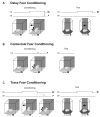Assessment of Cognitive Phenotyping in Inbred, Genetically Modified Mice, and Transgenic Mouse Models of Alzheimer's Disease
- PMID: 31138986
- PMCID: PMC6526110
- DOI: 10.5607/en.2019.28.2.146
Assessment of Cognitive Phenotyping in Inbred, Genetically Modified Mice, and Transgenic Mouse Models of Alzheimer's Disease
Abstract
Genetically modified mouse models are being used predominantly to understand brain functions and diseases. Well-designed and controlled behavioral analyses of genetically modified mice have successfully led to the identification of gene functions, understanding of brain diseases, and development of treatments. Recently, complex and higher cognitive functions have been examined in mice with genetic mutations. Therefore, research strategies for cognitive phenotyping should be sophisticated and evolve to convey the exact meaning of the findings and provide robust translational tools for testing hypotheses and developing treatments. This review addresses issues of experimental design and discusses studies that have examined cognitive function using mouse strain differences, genetically modified mice, and transgenic mice for Alzheimer's disease.
Keywords: Fear conditioning; Hippocampus; Mice; Object recognition; Prefrontal cortex; Water maze.
Figures






References
-
- Crawley JN. Behavioral phenotyping strategies for mutant mice. Neuron. 2008;57:809–818. - PubMed
-
- Crawley JN, Belknap JK, Collins A, Crabbe JC, Frankel W, Henderson N, Hitzemann RJ, Maxson SC, Miner LL, Silva AJ, Wehner JM, Wynshaw-Boris A, Paylor R. Behavioral phenotypes of inbred mouse strains: implications and recommendations for molecular studies. Psychopharmacology Berl. 1997;132:107–124. - PubMed
-
- Crawley JN, Paylor R. A proposed test battery and constellations of specific behavioral paradigms to investigate the behavioral phenotypes of transgenic and knockout mice. Horm Behav. 1997;31:197–211. - PubMed
-
- Ruys T. Handbook of facilities planning. Volume 2. Laboratory animal facilities. New York, NY: Van Nostrand Reinhold; 1991.
-
- Crabbe JC, Wahlsten D, Dudek BC. Genetics of mouse behavior: interactions with laboratory environment. Science. 1999;284:1670–1672. - PubMed

